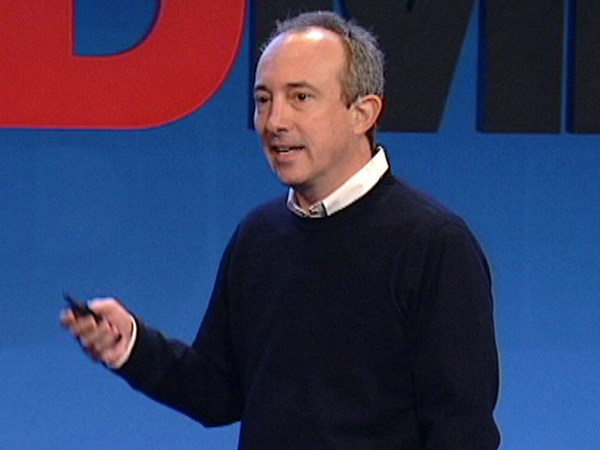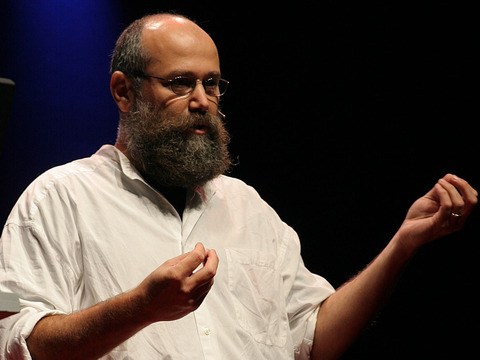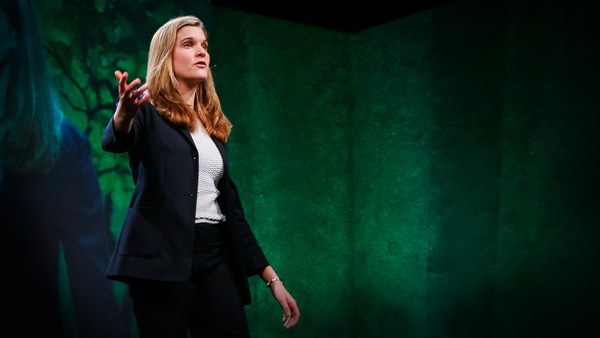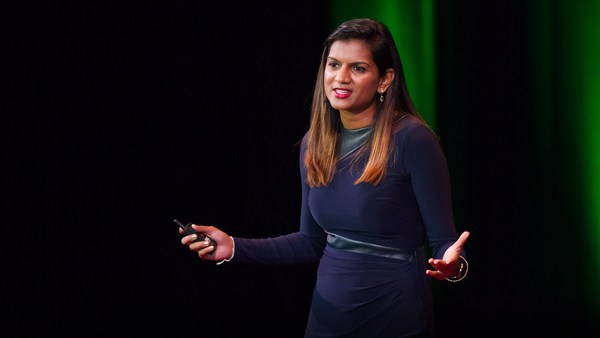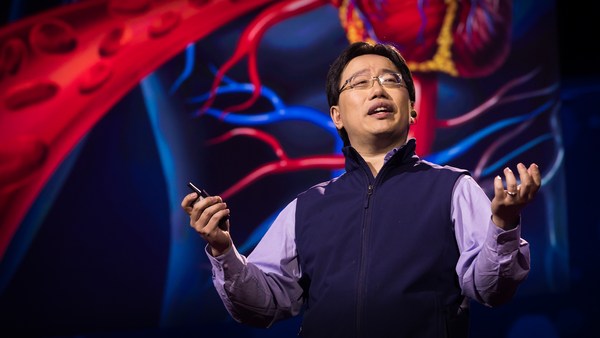I moved to Boston 10 years ago from Chicago, with an interest in cancer and in chemistry. You might know that chemistry is the science of making molecules or, to my taste, new drugs for cancer. And you might also know that, for science and medicine, Boston is a bit of a candy store. You can't roll a stop sign in Cambridge without hitting a graduate student. The bar is called the Miracle of Science. The billboards say "Lab Space Available."
And it's fair to say that in these 10 years, we've witnessed absolutely the start of a scientific revolution -- that of genome medicine. We know more about the patients that enter our clinic now than ever before. And we're able, finally, to answer the question that's been so pressing for so many years: Why do I have cancer? This information is also pretty staggering. You might know that, so far, in just the dawn of this revolution, we know that there are perhaps 40,000 unique mutations affecting more than 10,000 genes, and that there are 500 of these genes that are bona-fide drivers, causes of cancer.
Yet comparatively, we have about a dozen targeted medications. And this inadequacy of cancer medicine really hit home when my father was diagnosed with pancreatic cancer. We didn't fly him to Boston. We didn't sequence his genome. It's been known for decades what causes this malignancy. It's three proteins: ras, myc, p53. This is old information we've known since about the 80s, yet there's no medicine I can prescribe to a patient with this or any of the numerous solid tumors caused by these three ... Horsemen of the Apocalypse that is cancer. There's no ras, no myc, no p53 drug.
And you might fairly ask: Why is that? And the very unsatisfying yet scientific answer is: it's too hard. That for whatever reason, these three proteins have entered a space, in the language of our field, that's called the undruggable genome -- which is like calling a computer unsurfable or the Moon unwalkable. It's a horrible term of trade. But what it means is that we've failed to identify a greasy pocket in these proteins, into which we, like molecular locksmiths, can fashion an active, small, organic molecule or drug substance.
Now, as I was training in clinical medicine and hematology and oncology and stem-cell transplantation, what we had instead, cascading through the regulatory network at the FDA, were these substances: arsenic, thalidomide, and this chemical derivative of nitrogen mustard gas. And this is the 21st century. And so, I guess you'd say, dissatisfied with the performance and quality of these medicines, I went back to school, in chemistry, with the idea that perhaps by learning the trade of discovery chemistry and approaching it in the context of this brave new world of the open source, the crowd source, the collaborative network that we have access to within academia, that we might more quickly bring powerful and targeted therapies to our patients.
And so, please consider this a work in progress, but I'd like to tell you today a story about a very rare cancer called midline carcinoma, about the undruggable protein target that causes this cancer, called BRD4, and about a molecule developed at my lab at Dana-Farber Cancer Institute, called JQ1, which we affectionately named for Jun Qi, the chemist that made this molecule. Now, BRD4 is an interesting protein.
You might ask: with all the things cancer's trying to do to kill our patient, how does it remember it's cancer? When it winds up its genome, divides into two cells and unwinds again, why does it not turn into an eye, into a liver, as it has all the genes necessary to do this? It remembers that it's cancer. And the reason is that cancer, like every cell in the body, places little molecular bookmarks, little Post-it notes, that remind the cell, "I'm cancer; I should keep growing." And those Post-it notes involve this and other proteins of its class -- so-called bromodomains. So we developed an idea, a rationale, that perhaps if we made a molecule that prevented the Post-it note from sticking by entering into the little pocket at the base of this spinning protein, then maybe we could convince cancer cells, certainly those addicted to this BRD4 protein, that they're not cancer.
And so we started to work on this problem. We developed libraries of compounds and eventually arrived at this and similar substances called JQ1. Now, not being a drug company, we could do certain things, we had certain flexibilities, that I respect that a pharmaceutical industry doesn't have. We just started mailing it to our friends. I have a small lab. We thought we'd just send it to people and see how the molecule behaves. We sent it to Oxford, England, where a group of talented crystallographers provided this picture, which helped us understand exactly how this molecule is so potent for this protein target. It's what we call a perfect fit of shape complementarity, or hand in glove.
Now, this is a very rare cancer, this BRD4-addicted cancer. And so we worked with samples of material that were collected by young pathologists at Brigham and Women's Hospital. And as we treated these cells with this molecule, we observed something really striking. The cancer cells -- small, round and rapidly dividing, grew these arms and extensions. They were changing shape. In effect, the cancer cell was forgetting it was cancer and becoming a normal cell.
This got us very excited. The next step would be to put this molecule into mice. The only problem was there's no mouse model of this rare cancer. And so at the time we were doing this research, I was caring for a 29-year-old firefighter from Connecticut who was very much at the end of life with this incurable cancer. This BRD4-addicted cancer was growing throughout his left lung. And he had a chest tube in that was draining little bits of debris. And every nursing shift, we would throw this material out. And so we approached this patient and asked if he would collaborate with us. Could we take this precious and rare cancerous material from this chest tube and drive it across town and put it into mice and try to do a clinical trial at a stage that with a prototype drug, well, that would be, of course, impossible and, rightly, illegal to do in humans. And he obliged us. At the Lurie Family Center for Animal Imaging, our colleague, Andrew Kung, grew this cancer successfully in mice without ever touching plastic.
And you can see this PET scan of a mouse -- what we call a pet PET. The cancer is growing as this red, huge mass in the hind limb of this animal. And as we treat it with our compound, this addiction to sugar, this rapid growth, faded. And on the animal on the right, you see that the cancer was responding. We've completed, now, clinical trials in four mouse models of this disease. And every time, we see the same thing. The mice with this cancer that get the drug live, and the ones that don't rapidly perish.
So we started to wonder, what would a drug company do at this point? Well, they probably would keep this a secret until they turn the prototype drug into an active pharmaceutical substance. So we did just the opposite. We published a paper that described this finding at the earliest prototype stage. We gave the world the chemical identity of this molecule, typically a secret in our discipline. We told people exactly how to make it. We gave them our email address, suggesting that if they write us, we'll send them a free molecule.
(Laughter)
We basically tried to create the most competitive environment for our lab as possible. And this was, unfortunately, successful.
(Laughter)
Because now, we've shared this molecule, just since December of last year, with 40 laboratories in the United States and 30 more in Europe -- many of them pharmaceutical companies, seeking now to enter this space, to target this rare cancer that, thankfully right now, is quite desirable to study in that industry. But the science that's coming back from all of these laboratories about the use of this molecule has provided us insights we might not have had on our own. Leukemia cells treated with this compound turn into normal white blood cells. Mice with multiple myeloma, an incurable malignancy of the bone marrow, respond dramatically to the treatment with this drug. You might know that fat has memory. I'll nicely demonstrate that for you.
(Laughter)
In fact, this molecule prevents this adipocyte, this fat stem cell, from remembering how to make fat, such that mice on a high-fat diet, like the folks in my hometown of Chicago --
(Laughter)
fail to develop fatty liver, which is a major medical problem.
What this research taught us -- not just my lab, but our institute, and Harvard Medical School more generally -- is that we have unique resources in academia for drug discovery; that our center, which has tested perhaps more cancer molecules in a scientific way than any other, never made one of its own. For all the reasons you see listed here, we think there's a great opportunity for academic centers to participate in this earliest, conceptually tricky and creative discipline of prototype drug discovery.
So what next? We have this molecule, but it's not a pill yet. It's not orally bioavailable. We need to fix it so we can deliver it to our patients. And everyone in the lab, especially following the interaction with these patients, feels quite compelled to deliver a drug substance based on this molecule. It's here where I'd say that we could use your help and your insights, your collaborative participation. Unlike a drug company, we don't have a pipeline that we can deposit these molecules into. We don't have a team of salespeople and marketeers to tell us how to position this drug against the other. What we do have is the flexibility of an academic center to work with competent, motivated, enthusiastic, hopefully well-funded people to carry these molecules forward into the clinic while preserving our ability to share the prototype drug worldwide.
This molecule will soon leave our benches and go into a small start-up company called Tensha Therapeutics. And, really, this is the fourth of these molecules to kind of "graduate" from our little pipeline of drug discovery, two of which -- a topical drug for lymphoma of the skin and an oral substance for the treatment of multiple myeloma -- will actually come to the bedside for the first clinical trial in July of this year -- for us, a major and exciting milestone. I want to leave you with just two ideas. The first is: if anything is unique about this research, it's less the science than the strategy. This, for us, was a social experiment -- an experiment in "What would happen if we were as open and honest at the earliest phase of discovery chemistry research as we could be?"
This string of letters and numbers and symbols and parentheses that can be texted, I suppose, or Twittered worldwide, is the chemical identity of our pro compound. It's the information that we most need from pharmaceutical companies, the information on how these early prototype drugs might work. Yet this information is largely a secret. And so we seek, really, to download from the amazing successes of the computer-science industry, two principles -- that of open source and that of crowdsourcing -- to quickly, responsibly accelerate the delivery of targeted therapeutics to patients with cancer.
Now, the business model involves all of you. This research is funded by the public. It's funded by foundations. And one thing I've learned in Boston is that you people will do anything for cancer, and I love that. You bike across the state, you walk up and down the river.
(Laughter)
I've never seen, really, anywhere, this unique support for cancer research. And so I want to thank you for your participation, your collaboration and most of all, for your confidence in our ideas.
(Applause)
